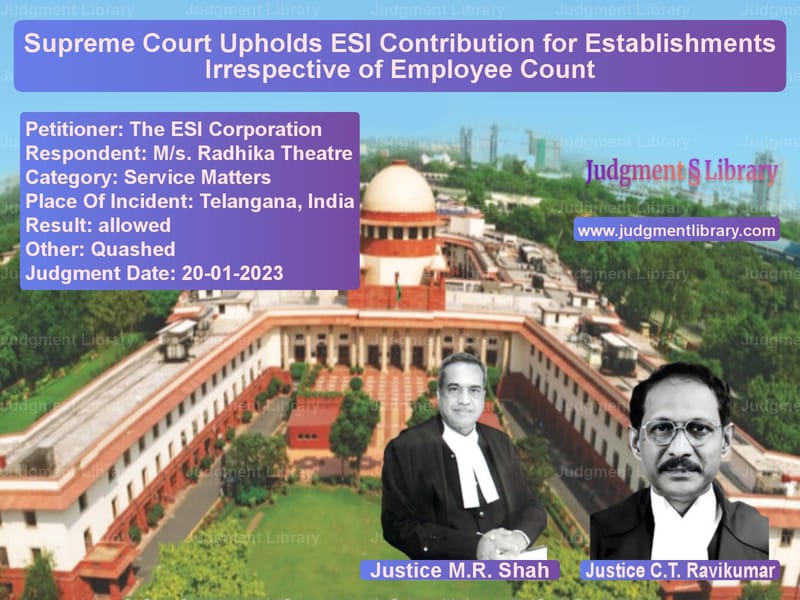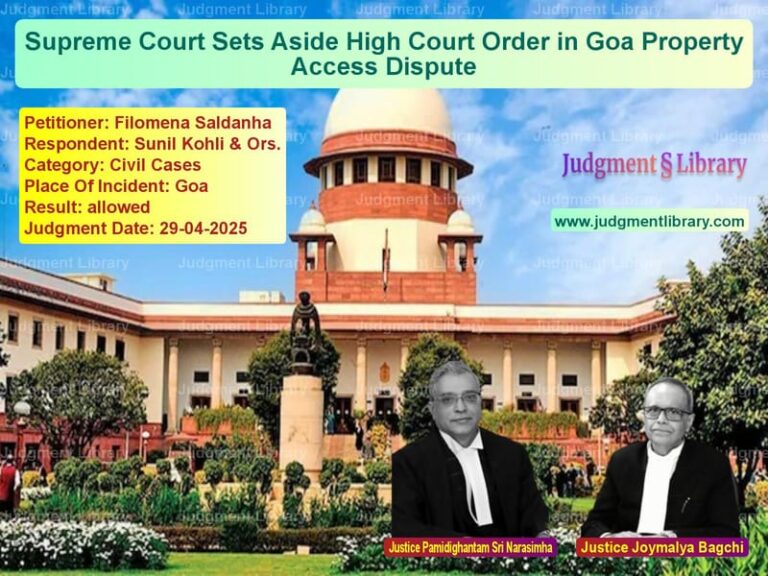Supreme Court Upholds ESI Contribution for Establishments Irrespective of Employee Count
The case of The ESI Corporation v. M/s. Radhika Theatre involves a significant ruling on the applicability of the Employees’ State Insurance (ESI) Act, 1948. The Supreme Court overturned the Telangana High Court’s ruling and upheld the validity of demand notices issued to establishments for ESI contributions, irrespective of whether their employee count fell below the statutory limit after the enforcement of Section 1(6) of the ESI Act. The judgment reinforces the intent of the ESI Act as a social welfare legislation.
Background of the Case
The respondent, M/s. Radhika Theatre, had been running a cinema theatre since 1981 and was contributing to the ESI scheme until September 1989. However, after that period, it ceased contributions, citing that the number of employees had fallen below 20, the statutory requirement at the time for ESI applicability.
On October 20, 1989, the government amended the ESI Act by inserting Section 1(6), which extended ESI coverage to all establishments, even if their employee count fell below the previously prescribed limit. Based on this amendment, the ESI Corporation issued demand notices requiring M/s. Radhika Theatre to continue ESI contributions.
The respondent challenged these notices before the Employees’ Insurance Court (EI Court), which dismissed their claim on December 13, 2010, upholding the demand notices. The respondent then appealed to the Telangana High Court, which ruled in their favor, stating that the amendment could not be applied retrospectively. The ESI Corporation, dissatisfied with the ruling, appealed to the Supreme Court.
Key Legal Issues
1. Whether Section 1(6) of the ESI Act Applies to Establishments Existing Before 1989?
The respondent contended that the amendment could not apply to establishments that were already in existence before the amendment date (October 20, 1989).
The ESI Corporation argued that the amendment was intended to ensure continued coverage for employees, regardless of fluctuations in workforce size, and should apply to all establishments, even those established before the amendment.
2. Does the Amendment Operate Retrospectively?
The High Court ruled that applying Section 1(6) to M/s. Radhika Theatre was retrospective, and therefore, the demand notices were invalid.
The Supreme Court disagreed, ruling that the provision did not operate retrospectively but prospectively from the date of enforcement (October 20, 1989). Consequently, demand notices issued for the period after this date were legally valid.
3. Is the ESI Act a Social Welfare Legislation?
The Supreme Court reaffirmed that the ESI Act is a social welfare legislation, designed to provide health insurance and benefits to employees in case of sickness, maternity, and employment injury.
The Court stated:
“The ESI Act should be given liberal interpretation and should be interpreted in such a manner so that social security can be given to the employees.”
Supreme Court’s Judgment
The Supreme Court ruled in favor of the ESI Corporation, stating:
“The amendment to Section 1 inserting Sub-section (6) shall be applicable even to establishments established prior to 31.03.1989/20.10.1989, and the ESI Act shall be applicable irrespective of the number of persons employed or whether the number falls below the limit specified.”
The Court set aside the High Court’s ruling and restored the demand notices for the period after October 20, 1989.
Implications of the Judgment
This judgment has far-reaching consequences for businesses and employees:
- Clarifies ESI Coverage: All establishments, irrespective of employee fluctuations, are required to comply with ESI contributions.
- Prevents Employers from Avoiding Liability: The ruling prevents businesses from reducing employee count to evade ESI obligations.
- Upholds Employee Welfare: The decision ensures continued social security benefits for workers, reinforcing the purpose of the ESI Act.
Conclusion
The Supreme Court’s ruling in The ESI Corporation v. M/s. Radhika Theatre reinforces the intent of the ESI Act as a social security law. It ensures that employees remain protected under the scheme regardless of temporary workforce fluctuations. This judgment will serve as an important precedent for future disputes regarding the applicability of the ESI Act to businesses of all sizes.
Petitioner Name: The ESI Corporation.Respondent Name: M/s. Radhika Theatre.Judgment By: Justice M.R. Shah, Justice C.T. Ravikumar.Place Of Incident: Telangana, India.Judgment Date: 20-01-2023.
Don’t miss out on the full details! Download the complete judgment in PDF format below and gain valuable insights instantly!
Download Judgment: the-esi-corporation-vs-ms.-radhika-theatre-supreme-court-of-india-judgment-dated-20-01-2023.pdf
Directly Download Judgment: Directly download this Judgment
See all petitions in Employment Disputes
See all petitions in Public Sector Employees
See all petitions in Legal Malpractice
See all petitions in Pension and Gratuity
See all petitions in Judgment by Mukeshkumar Rasikbhai Shah
See all petitions in Judgment by C.T. Ravikumar
See all petitions in allowed
See all petitions in Quashed
See all petitions in supreme court of India judgments January 2023
See all petitions in 2023 judgments
See all posts in Service Matters Category
See all allowed petitions in Service Matters Category
See all Dismissed petitions in Service Matters Category
See all partially allowed petitions in Service Matters Category







